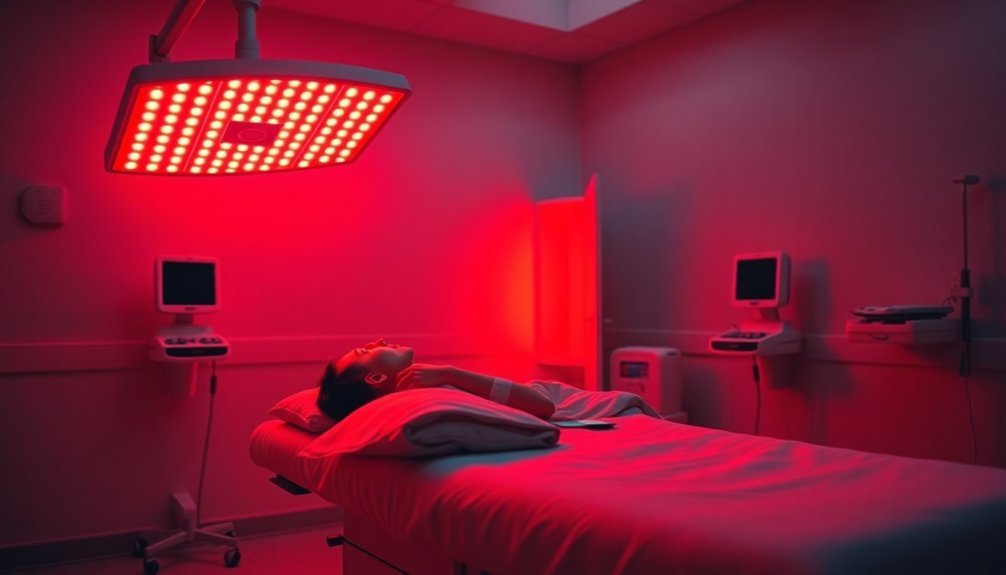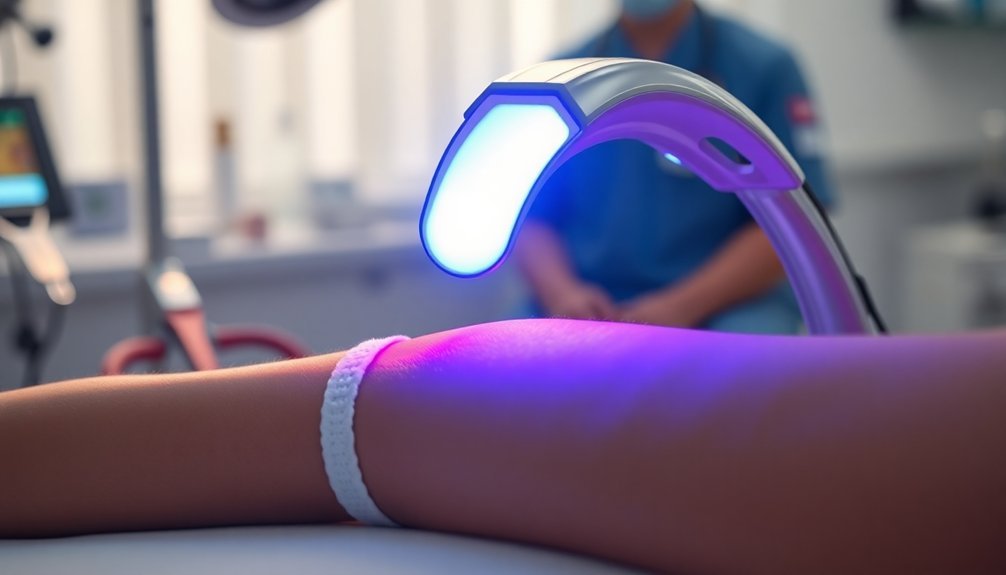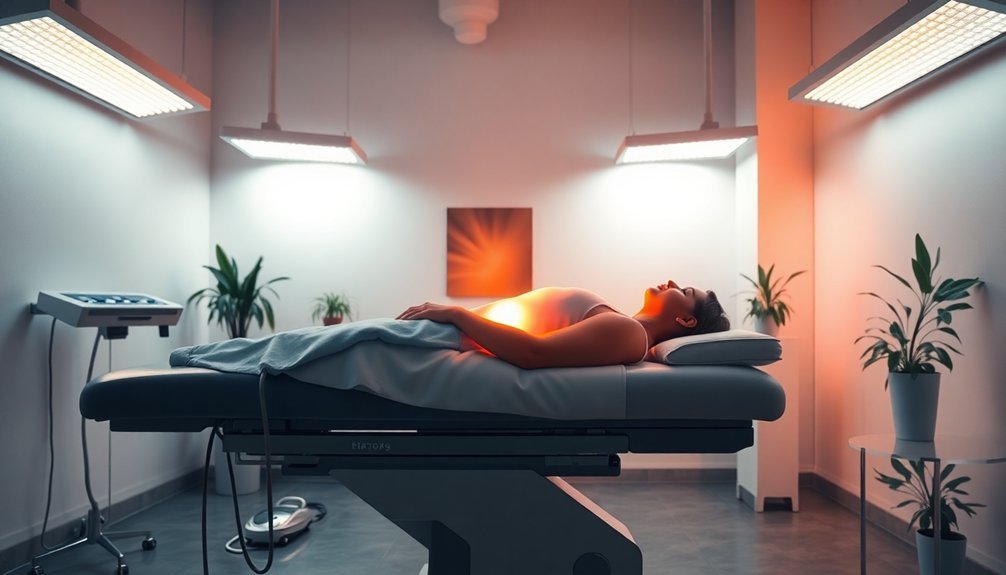If you're looking to speed up wound recovery, consider these three light therapies. First, red light therapy uses low-wavelength light to boost ATP production, reduce inflammation, and promote collagen formation. Next, near-infrared therapy penetrates deep into the skin, enhancing blood flow and minimizing pain. Finally, combination light devices merge both therapies, offering a thorough approach that effectively stimulates healing. These treatments are generally safe, non-invasive, and can be done at home. Want to dive deeper into how these therapies can specifically benefit your recovery?
Red Light Therapy

Red light therapy harnesses the power of low-wavelength red light to enhance wound recovery. By exposing your body to this light, it penetrates deep into your skin and is absorbed by your cells' mitochondria. This absorption boosts the production of adenosine triphosphate (ATP), your cells' main energy source, which accelerates cellular energy creation. As a result, you experience faster healing and regeneration.
The therapy also reduces oxidative stress and inflammation, common hurdles after injuries and surgeries. It promotes angiogenesis, forming new blood vessels, and increases fibroblast production, essential for collagen and connective tissue development. Additionally, it enhances the production of growth factors, aiding in tissue repair and collagen synthesis.
Studies have shown that red light therapy can notably speed up wound healing, particularly for chronic wounds, surgical sites, and burns. It aids in the shift through different healing stages by enhancing tissue granulation, ultimately leading to stronger and more resilient skin.
Importantly, red light therapy is generally safe and non-invasive with minimal side effects when used as directed. Typical treatment sessions last 10 to 20 minutes, applied one to three times daily, and tailored to the specific wound type for best results.
Always consult a healthcare professional for the best guidance on your treatment plan.
Near-Infrared Therapy
Near-infrared therapy offers a powerful approach to enhance wound recovery, utilizing wavelengths in the 800-830 nm range for ideal effectiveness. This range penetrates deeply into the skin, promoting faster healing by increasing blood flow and oxygen delivery to the wound site. It reduces inflammation and pain, making your recovery smoother. Recent findings indicate that using red and near-infrared light can significantly improve the healing process for chronic wounds.
Here's a quick overview of near-infrared therapy's benefits:
| Benefit | Description |
|---|---|
| Enhanced Blood Circulation | Boosts oxygen and nutrient delivery to the wound. |
| Accelerated Healing Process | Promotes cell growth and reduces healing time. |
| Pain and Swelling Reduction | Modulates inflammatory responses and alleviates discomfort. |
Studies show that consistent use of near-infrared therapy can markedly improve chronic wounds and post-surgical recovery outcomes. You can easily use LED devices to administer this therapy at home, making wound care both accessible and effective. This safe and cost-effective treatment method can help restore function and enhance the quality of new tissue, getting you back on track faster.
Combination Light Devices

Combining different light wavelengths can greatly enhance the healing process for wounds. For instance, using a combination of 633nm red light and 830nm near-infrared light has been shown to accelerate healing by increasing ATP production, boosting blood flow, reducing inflammation, and stimulating collagen production. Additionally, this combination is particularly effective due to its ability to stimulate cellular activity, ensuring a more efficient recovery process.
These benefits make such combinations ideal for pre-and post-surgery applications and aesthetic treatments like microdermabrasion.
Additionally, multi-wavelength devices that deliver red, blue, and near-infrared light work well after procedures like ablative fractional laser treatments. While studies indicate faster healing, outcomes might vary based on the wavelengths used.
LED technology further enhances these treatments by offering safe, cost-effective, and user-friendly options. Devices like the JustLight Sunflower provide consistent light energy, customizable settings, and have shown improved healing and tissue regeneration in clinical studies.
Regulatory-approved devices, like Celluma, also demonstrate effectiveness in speeding up wound closure. Their clinical backing supports usage across various professionals focused on skin and wound care.
Frequently Asked Questions
Is Light Therapy Safe for All Skin Types?
Yes, light therapy's safe for all skin types. It doesn't use UV light, preventing burns. Rare side effects occur, but overall, you can enjoy the benefits without worrying about damage or skin color sensitivity.
How Often Should I Use Light Therapy for Wounds?
You should use light therapy for wounds 5-7 times a week, with sessions lasting 10-20 minutes. Always consult your healthcare provider to determine the ideal frequency and duration based on your specific needs.
Can Light Therapy Be Combined With Other Treatments?
Yes, you can combine light therapy with other treatments like arginine supplementation or aesthetic procedures. This combination enhances healing, reduces side effects, and boosts cellular regeneration, leading to faster recovery and stronger tissue.
How Long Does a Typical Light Therapy Session Last?
A typical light therapy session lasts about 10 to 20 minutes, depending on the condition you're treating. For deeper tissues or chronic issues, sessions might extend up to 30 minutes for ideal results.
Are There Any Side Effects of Light Therapy?
Yes, light therapy can cause side effects like headaches, eye strain, and skin irritation. It's important to wear proper protective eyewear and start with shorter sessions to gauge your skin's reaction. Always consult your provider if unsure.
In Summary
Incorporating light therapy into your wound care routine can markedly enhance your healing process. Whether you choose red light therapy for its cellular benefits, near-infrared therapy for deeper tissue repair, or a combination device for a rounded approach, you're making a smart choice. Each method offers unique advantages to speed up recovery and improve overall skin health. So, don't hesitate to explore these therapies and find the best fit for your needs—your wounds will thank you!





Leave a Reply